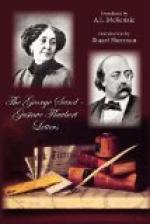“They were marching through a wide defile, hedged in by two chains of reddish hillocks, when a nauseous odor struck their nostrils, and they believed that they saw something extraordinary at the top of a carob tree; a lion’s head stood up above the foliage.
“Running towards it, they found a lion attached to a cross by its four limbs, like a criminal; his enormous muzzle hung to his breast, and his forepaws, half concealed beneath the abundance of his mane, were widely spread apart, like a bird’s wings in flight; under the tightly drawn skin, his ribs severally protruded and his hind legs were nailed together, but were slightly drawn up; black blood had trickled through the hairs, and collected in stalactites at the end of his tail, which hung straight down the length of the cross. The soldiers crowded around the beast, diverting themselves by calling him ‘Consul!’ and ‘Citizen of Rome!’ and threw pebbles into his eyes to scatter the swarming gnats.”
And now take any characteristic series of pictures or incidents from Madame Bovary: take Bovary’s bungling and gruesome operations on the club-footed ostler’s leg, with the entire village clustering agape; take the picture of the eyeless, idiotic beggar on the road to Rouen; or the scene in which Emma offers herself for three thousand francs to Rodolphe; or the following bit, only a bit, from the detailed account of the heroine’s last hours, after the arsenical poisoning:
“Emma’s head was turned towards her right shoulder, the corner of her mouth, which was open, seemed like a black hole at the lower part of her face; her two thumbs were bent into the palms of her hands; a kind of white dust besprinkled her lashes, and her eyes were beginning to disappear in that viscous pallor that looks like a thin web, as if spiders had spun it over. The sheet sunk in from her breast to her knees, and then rose at the tips of her toes, and it seemed to Charles that infinite masses, an enormous load, were weighing upon her.
“The church clock struck two. They could hear the loud murmur of the river flowing in the darkness at the foot of the terrace. Monsieur Bournisien from time to time blew his nose noisily and Homais’ pen was scratching over the paper.”
In these two detached pictures—the one from a so-called “romantic,” the other from a so-called “realistic” book—one readily observes the likeness in the subjects, which are of a ghastly repulsiveness; the same minuteness of observation—e.g., the lion’s hind legs “slightly drawn up,” the woman’s thumbs “bent into the palms of her hands”; the same careful notation of effect on the several senses; the same rhetorical heightening—e.g., the “stalactites at the end of his tail,” the web in the woman’s eyes “as if spiders had spun it over”; and finally, that celebrated detachment, that air as of a medical examiner, recording the results of an autopsy. What can we know of such an author? All, or nearly all, that he knew of himself, provided we will searchingly ask ourselves what sort of mind is steadily attracted to the painting of such pictures, to the representation of such incidents, and what sort of mind expresses a lifetime of brooding on the significance of life in two such books as Madame Bovary and Salammbo.




